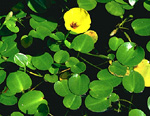 |
This small family is mainly tropical or subtropical with minor extensions into warmer temperate regions. In Australia, the few native and introduced species occur in temperate and tropical, usually permanent, freshwater swamps (except in Central Australia).
Characteristic features of the family Limnocharitaceae in Australia include: - perennial marsh or swamp plants with (at least in adult plants) large, emergent leaves with long petioles and broad, net-veined blades
- flowers borne in large, much-branched but basically umbellate inflorescences, relatively small but showy, with 6 free perianth segments the inner 3 of which are delicate, petal-like and white or yellow
- stamens 6 or numerous
- ovary superior, of few to many free carpels arranged in concentric whorls, each carpel splitting along one side at maturity to release several seeds
Description
Annual or perennial aquatic herbs rooted in the substrate with their leaves submerged or emergent. Perennating by rhizomes or crowns. Vegetative reproduction by rhizomes or stolons. Stem nodes not conspicuously swollen; internodes spongy or pithy. Internal secretions of milky sap (latex). Plants glabrous. Leaves alternate and spiral, or distichous, all or mostly basal, petiolate. Stipule-like lobes absent. Lamina simple, symmetric, filiform, acicular, subulate, linear, lanceolate, ovate, elliptic, oblanceolate, obovate or orbicular; base cuneate, attenuate or cordate; margins entire, ±flat; venation parallel, with the midrib conspicuous or inconspicuous, and the tertiary venation reticulate; surfaces not punctate; herbaceous. Leaf ligule absent. All the flowers bisexual. Inflorescences terminal, consisting of umbels or solitary flowers. Bracts present. Flowers stalked. Floral disc absent; nectaries present on the carpels. Perianth regular, of 2 dissimilar whorls, imbricate in bud; herbaceous. Calyx segments free, with 3 sepals. Corolla segments free, with 3 petals, alternating with the sepals, white or yellow, without contrasting markings, membranous; claws absent; lobes ±entire. Fertile stamens 8–10, not clearly correlated with the sepals, free of the corolla, free of the ovary and style, distinct from each other, all ±equal. Anthers basifixed, not versatile, opening sideways by longitudinal slits, 2-celled. Ovary superior and sessile. Carpels 3, or 5–9, or 12–20, free from each other. Style terminal. Ovules numerous per carpel, sessile; placentation parietal. Fruit a dry, dehiscent follicle; the perianth on the maturing fruit deciduous or dry and persistent. Disseminule micro-surface ±smooth or verrucose, dull. Seeds numerous per fruit. Aril absent. Cotyledons 1. Embryo straight or curved.
(Note: this description has been generated from the coded data compiled for the key. Any errors in the key data will be reflected in the descriptions.)
A treatment of the family Limnocharitaceae has not yet been published in the Flora of Australia. It will appear in Volume 39.
Australian genera of Limnocharitaceae (as recognised for the Flora of Australia)
Butomopsis
Hydrocleys
Tenagocharis

|
  |

Hydrocleys nymphoides (flowering plant)
Photo: S.Jacobs © S.Jacobs

Hydrocleys nymphoides (flowers)
Photo: S.Jacobs © S.Jacobs
|

| |